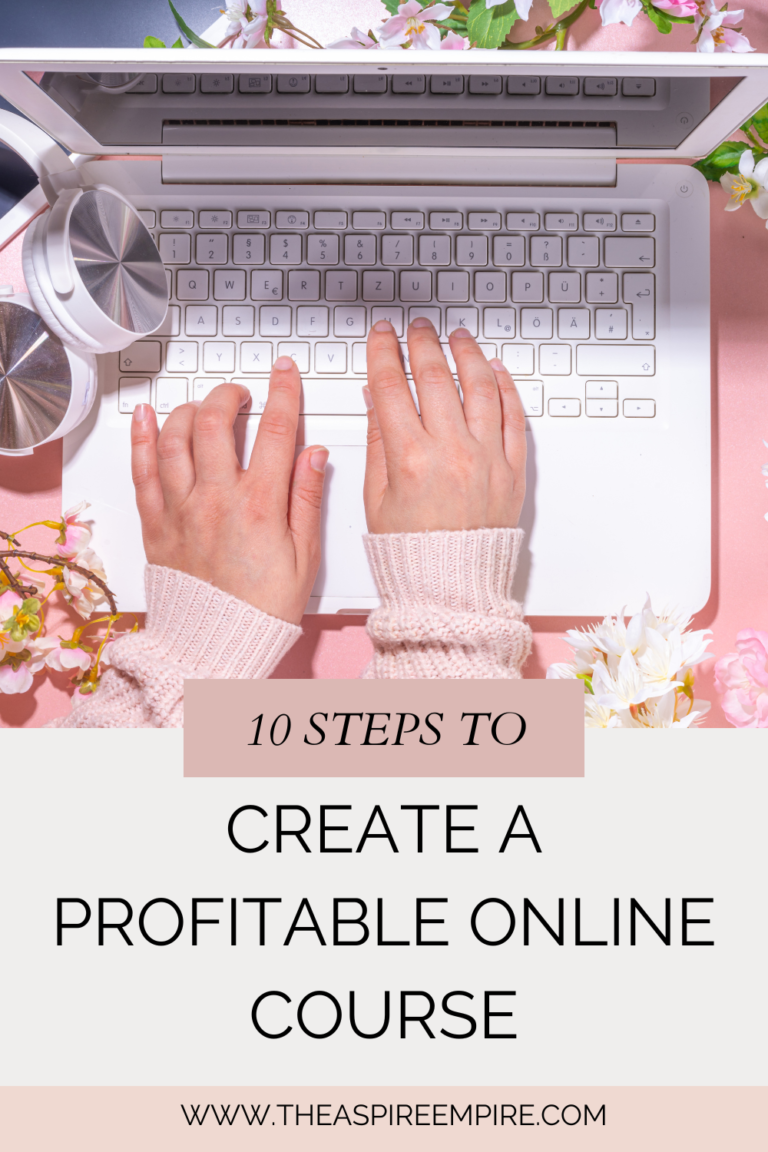
10 Steps To Create A Profitable Online Course
In today’s digital age, the demand for online education is skyrocketing. With the rise of e-learning platforms and technological advancements, creating and selling your own online course has become more accessible than ever before.
Whether you’re an expert in a specific field or possess valuable skills worth sharing, developing an online course can be a rewarding venture both intellectually and financially.
If you’re ready to embark on this journey, here’s a comprehensive guide to help you create an impactful and successful online course in just 10 steps.
Affiliate Disclaimer: This post includes affiliate links which means if you make a purchase, I may make a small commission at no extra cost to you. I only recommend products that I absolutely love!
1. Choose a course topic and identify your Audience
The first step in creating an online course is to identify your area of expertise. This will be your course topic, aka your niche. To pick a niche, reflect on your skills, knowledge, and passions to determine what subject matter you can teach effectively.
The topic you choose should be something that you love talking about. A topic that really excites you and something that you love to share with others. If you are struggling to come up with a niche for your course, I have actually compiled a list of the most profitable ones. You can access the guide for free here:.
You will also need to identify who your target audience is. These are the people who will be your loyal followers and they will most likely convert into paying customers. As a starting point, consider what problems or challenges your audience faces and how your course can provide solutions or valuable insights.
I recommend conducting market research to understand your target audience’s demographics, interests, and preferences. This will help tailor your course content to their needs. Remember, you should always be creating content that caters to your target audience.
2. Define Your Course Objectives and Learning Outcomes
It is important to clearly define the objectives and learning outcomes of your course. Ask yourself what it is that you want your students to achieve by the end of the course? Break down the learning objectives into specific, measurable, achievable, relevant, and time-bound (SMART) goals. This will guide your course content creation and ensure that your students gain tangible skills and knowledge upon completion.
3. Create Your Course Outline
Developing your course outline is a very important step in the course creation process. It will act as your guideline while you are creating learning materials. You will want to structure your course with modules, lessons, and activities. I recommend dividing your content into manageable sections to facilitate learning and engagement. And most importantly you will need to decide on the format of your content. This could be video lectures, written tutorials, quizzes, assignments, interactive discussions or all of the above. It is beneficial to Incorporate a variety of multimedia elements to cater to different learning styles and enhance the learning experience.
4. Create Compelling Content
It is important to develop high-quality content that is informative, engaging, and easy to understand. Present your material in a structured and organized manner, using clear explanations, examples, and visuals to reinforce learning. And don’t forget to use your personality to add authenticity and credibility to your course.
You will also need to Invest in professional equipment and software to produce polished videos and multimedia content. Now, you don’t need to run out and spend thousands on fancy equipment but you will need a decent camera if you plan to record video lectures. The Sony camera is a very popular one among content creators and it shoots in 4k.
If you plan on recording slides then I would highly recommend using Canva. Canva is an easy, user-friendly platform for creators to create all sorts of multi media!
5. Pick an Online Course Platform
Once you have created your course content, you will need to choose a reliable online course platform to host and deliver your course. If you Google online course platforms, quite a few will pop up! I have dibble dabbled in a handful and I cannot recommend Systeme.io more!
With System.io you are provided with a platform for not only your course but you are also given some incredibly valuable marketing tools. They offer email automation, funnel building, free templates, trainings and so much more. What’s even better is you can start for free. To me it was a total no brainer.
You can check them out here. A solid course hosting platform is so important because they streamline the course creation and selling process by offering user-friendly interfaces, built-in marketing tools, and payment processing capabilities.

6. Design Engaging Assessments and Activities
It’s important to keep your students engaged and participating throughout the entirety of your course. I recommend Incorporating assessments and activities throughout your course to reinforce learning and measure each student’s progress. You can include quizzes, assignments, projects, and discussions to encourage active participation and critical thinking.
I often provide constructive feedback to help my students improve their skills and understanding. Offering one on one coaching is also extremely valuable. Coaching can be used as an upsell when promoting your course as well.
7. Launch and Promote Your Course Regularly
You will need to create a launch strategy and a comprehensive marketing plan to promote your course and attract students. Launching consists of multiple steps that are all equally important. You will have your pre launch period which is where awareness begins. In this stage you will be teasing your audience and giving them tid bits before you fully launch.
It’s imperative that you create compelling promotional materials, such as teaser videos, testimonials, and course previews, to showcase the value of your course. In the pre launch stage you will also be collecting emails to build your contact list and you can even pre sell your course!
On your actual launch date it will get more hectic! Most creators launch for 2 weeks and during this time they are continuously advertising. It’s very helpful to offer special promotions, discounts, or bonuses to incentivize enrollment and generate buzz. Promotional content should be shared daily until your launch window closes.
Remember, once your course launch ends it does not mean that you stop promoting your course. You will need to create a specialized marketing plan for your business and set your course on evergreen. Evergreen means you are always actively promoting your course through various types of content. You should be leveraging social media, email marketing, blogging, and search engine optimization (SEO) to increase visibility and reach your target audience.

8. Engage with Your Students
In addition to the course itself, you should also build a supportive learning community by actively engaging with your students. You can do this by creating a private Facebook group for just your clients or holding weekly Q & A sessions on your social media profiles.
Remember to respond promptly to questions, provide guidance, support, and foster discussions and collaboration among your students. Encourage peer-to-peer interaction and knowledge sharing to enhance the learning experience.
You can even offer live group coaching sessions, webinars, or online chat hours to connect with your students in real-time to address their needs and concerns.
9. Continuously Improve Your Course
Creating an online course and maintaining a community is a constant, always changing process. It’s important to gather feedback from your students through surveys, reviews, and course evaluations. Then take this feedback and analyze the data to identify strengths, weaknesses, and areas for improvement.
You should incorporate constructive feedback to refine your course content, delivery, and structure. Stay updated on industry trends, best practices, and emerging technologies to keep your course relevant and competitive. It is also important to continuously iterate and update your course to provide value and meet the evolving needs of your audience.
10. Scale Your Course and Expand Your Reach
Once you’ve established a successful online course, consider scaling your offerings and expanding your reach. You can develop additional courses or advanced modules to cater to different skill levels or niche markets. Collaborate with other experts or influencers to co-create courses or cross-promote each other’s offerings. Explore partnerships with educational institutions, companies, or organizations to reach new audiences and markets. Invest in marketing and advertising to increase brand awareness and attract a larger student base.
In conclusion, creating an online course is a rewarding endeavor that allows you to share your expertise, empower others, and generate passive income. By following these steps and leveraging the right tools and strategies, you can create a high-quality course that resonates with your audience and achieves your educational and business goals. Remember to stay passionate, flexible, and committed to providing value to your students, and success will follow.
Related Blog Post: 7 Course Topics That Make Money
Are you ready to create your own online course?
Have you attended our free training ?
